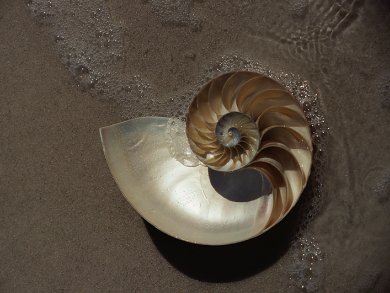Bio-Inspired
Biological materials are fascinating because they are very light but have the ability to withstand extreme forces. Nacre, also known as mother of pearl, is amazingly tough thanks to a multi-layer arrangement of platelet-shaped calcium carbonate crystals (“bricks”) and proteins (“mortar”) in the form of a “brick wall”. A Finnish and Swedish team headed by Andreas Walther and Olli Ikkala has now developed a nacre analogue with mechanical properties that outperform those of some high-performance polymers. It also acts as a heat shield, as the scientists report in the journal Angewandte Chemie.
There is much interest in the imitation of robust biomaterials and their use in construction and coatings. “It has previously been very difficult to even get samples of significant size” says Ikkala, “production scale was completely out of the question.” The team from the University of Aalto (Helsinki) and the Royal Institute of Technology in Stockholm has recently developed a simple and fast production method that resembles paper production, is environmentally friendly and economical, and can be used for the production of whisper-thin foils, laminates, and coatings of nacre analogues. The films can be made as large as desired and demonstrate outstanding mechanical properties.
Brick-Wall Structure
Like true nacre, the analogues have a brick-wall structure of “hard” and “soft” materials: The “bricks” consist of hard clay platelets that are coated with a soft polymer. The hard component acts as a supporting and strengthening member, while the soft segments is an efficient binder and can dissipate energy. Now there is a further improvement: the researchers coated the silicate platelets with polymer molecules that have multiple positive charges (polycations), instead of neutral polymers. By selecting the negatively charged counterions with the right properties, the mechanical properties of the highly transparent, pliable films can easily be varied, and improved. Increasing the charge increases the elasticity and tensile strength, because the adhesion between the polycation-coated platelets is stronger.
One other property of the new synthetic nacre analogues is particularly intriguing: when the materials are exposed to flame, the embedded polymer burns up to form a material with an interior of porous foam and an armored skin on the outside. This construction provides protection against heat and flames as effectively as a heat shield. “Our new material has potential as a fire-proof coating or as a component of fire- or heat-shielding films” says Walther. “Their light weight makes them particularly interesting for aerospace and marine applications.”
- Supramolecular Control of Stiffness and Strength in Lightweight High-Performance Nacre-Mimetic Paper with Fire-Shielding Properties
A. Walther, I. Bjurhager, J.-M. Malho, J. Ruokolainen, L. Berglund, O. Ikkala,
Angew. Chem. Int. Ed. 2010, 49(36), 6448–6453.
DOI: 10.1002/anie.201001577 - A. Walther, I. Bjurhager, J.-M. Malho, J. Ruokolainen, L. Berglund, O. Ikkala,
Angew. Chem. 2010, 122(36).
DOI: 10.1002/ange.201001577




